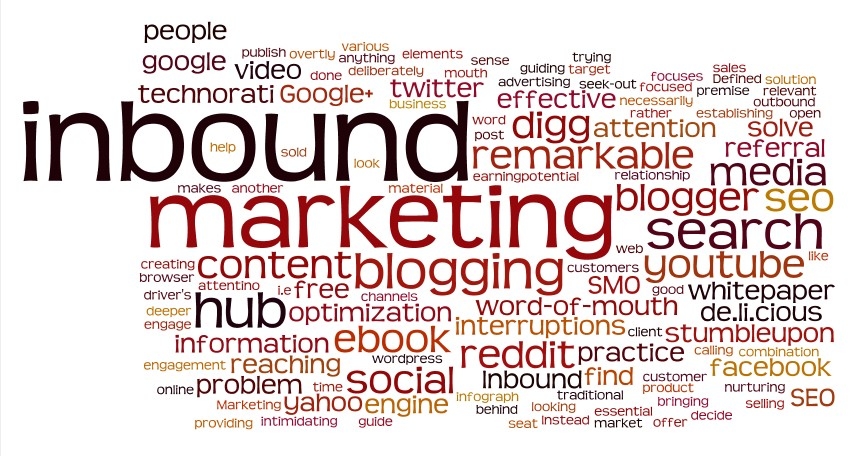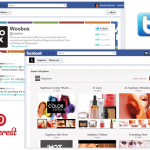What Is Inbound Marketing, Anyway?
Inbound marketing is the practice of online marketing that deliberately uses a combination of search engine optimization (SEO), various social media channels, and blogging to publish content that people will seek-out, find and engage with. The concept of Inbound marketing was first introduced to me by HubSpot, and from their founders’ latest book, Inbound Marketing.
 The premise behind inbound marketing is that customers are in the driver seat, and don’t like interruptions. When people are trying to solve a problem or find a solution, 98% of the time, they will open a web browser, and do a search. They are focused on and looking for information that will guide them or help them solve a problem, not necessarily to be sold on anything. So rather than you reaching out to them (i.e. outbound marketing or traditional advertising), they are calling and reaching out to you.
The premise behind inbound marketing is that customers are in the driver seat, and don’t like interruptions. When people are trying to solve a problem or find a solution, 98% of the time, they will open a web browser, and do a search. They are focused on and looking for information that will guide them or help them solve a problem, not necessarily to be sold on anything. So rather than you reaching out to them (i.e. outbound marketing or traditional advertising), they are calling and reaching out to you.
With effective inbound marketing, creating a ‘hub’ and bringing your target market to you. You are not overtly selling them, or intimidating them with sales and marketing material about how good you and your product are. Instead, you are providing them with relevant information, establishing a relationship, nurturing it, and guiding them to decide for themselves that doing business with you makes sense. This hub activity is a key to consumer engagement and growth in this new marketing era.
Inbound Marketing Elements
Let’s look at some of the essential elements to an effective inbound marketing practice, include (1) website optimization, (2) high-quality blogging, (3) social networking, and (4) eNewsletters & useful content.
1. Website Optimization
Having an optimized website does a lot for search engine results page (SERP) ranking. However, with inbound marketing, high ranking is not the only goal, and it’s not the only desired outcome. Good optimization helps make sure your site seldom deviates from its topic. When you look at keywords, you’re looking at a long list of potential topics for you to write about and share with your visitors. When done right, SEO leaves no room for accidentally off topic content, and consequently it ensures that your site is a wealthy source of information for people interested in your topic. This is key to inbound marketing, because remember, people want answers and they want them from sources that appear trustworthy.
2. High Quality Blogging

A lot can be said about blogging, and there’s much more detail throughout my blog. However, there are some essential highlights to consider. First, have passion for your topic and let it show through in your writting. Next, be consistent. Consider your blog as a part-time job. A few hours here and there, but with more dedication than a mere hobby. And last, check your work. Earn the respect from your following by delivering polished content.
3. Social Media
Yes, we brought out social media as an inbound marketing tool. Why? For the most part, it should fall in the realm of “passive” marketing. In other words, it’s not a place to pour your ads, discounts and company bravado. You can occasionally share this stuff, but the main point of social networking is to connect and network.
This is all merely an overview of principles, but there is much more depth in practice and execution. Studied rules like having at least one CTA (call-to-action) on every page, or making sure people can find the sign up for your newsletter are proven practices of good inbound marketing.
4. PDFs, eNewsletters & Useful Content
 There’s a lot of debate about whether e-mail newsletters really work. They do,but only if you are effective in using the proper steps to getting visitors to sign up. You can no longer send an email blast, or merely offer the newsletter subscription in tiny print hidden somewhere in the corner of your site. That doesn’t work anymore. Better technology and discerning readers deaden the one-time effectiveness of that.
There’s a lot of debate about whether e-mail newsletters really work. They do,but only if you are effective in using the proper steps to getting visitors to sign up. You can no longer send an email blast, or merely offer the newsletter subscription in tiny print hidden somewhere in the corner of your site. That doesn’t work anymore. Better technology and discerning readers deaden the one-time effectiveness of that.
So what’s necessary in the new realm of new, inbound marketing? Offering free, meaningful content. Things like white papers. If the content is good enough for people to want it, you can request name and email before allowing the download. Most people don’t mind a short, sweet few fields to complete, so long as they receive valuable content in their inbox as a result of it. Once you have that contact information, you continue to nurture it, not drown it, with more and more desirable content.
In summary, then, all these inbound marketing tools all have a few things in common. On the whole, they:
-
- Generate and continue to feed interest
- Increase your level of authority on your product or service subject matter
- Establish your brand without appearing self-promoting
Why Inbound Marketing Works
Lower Cost per Lead
So why do all this? Why not continue with the tried-and-true marketing practices of direct mail, tradeshows, and cold calls? Well, first, research from HubSpot shows that inbound marketing-focused businesses have a 61% lower cost per lead than traditional outbound-focused businesses. Lower cost, further reach. That’s the most desirable equation you can have in marketing.
Leveled Playing Field
Secondly, with inbound marketing, the playing field is leveled. Meaning, even the small guy can compete for eager eyeballs. Even the small business can now drill down to long-tail marketing and build out it’s own following and customer base. And with the right idea and strategy, it can even be done with velocity.
Don’t believe me? Just ask Ana White. She is an inbound marketing queen. There is just no other way to describe the Alaska-native, who only two years ago started a blog about woodworking and now has more than 1 million monthly unique visitors to her blog – enough that the advertising revenue from Lowes and Netflix (among others) now supports her family. You can read more on Ana’s inbound marketing success story from Social Media Examiner:





16 Comments
Comments are closed.